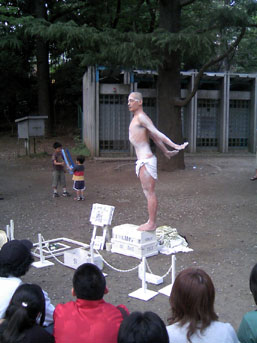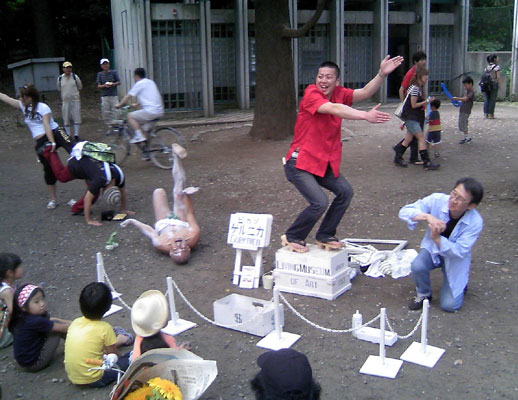The Living Museum of Art

This kind of outdoor performance art is hardly unique to Japan but there does seem to be something uniquely Japanese here in the casual appropriation of elements untroubled by context; in the bold references to visual signifiers minus what is signified. This approach can sometimes feel like the napalming of meaning leaving only the bare branches of form. When applied to famous paintings, it works like a reverse education to strip away everything we think we know, leaving only what we can actually see.
So, in the Living Museum of Art, a famous work such as The Scream is not, as art historians would have us believe, Edvard Munch’s bleak portrait of anxiety induced by nature’s indifference, but an iconic image of a figure clasping his face with both hands and screaming. Today’s scream is seemingly provoked by the indifference to Man of Tokyo’s municipal park furniture, but the source of tomorrow’s angst may be something else altogether (dog turd?)
Below, Picasso’s Guernica is rescued from its prior misclassification as a harrowing account of a Fascist air raid on a Basque town and restored to what it really is: a motley tableau of men, women, children and beasts with hitherto-untapped comic potential. Just look! The sheer joy experienced by ordinary people in assuming and then struggling to hold the posture of a machine-gunned horse (My legs! My legs!) is in itself a joy to behold.

Because the Living Museum of Art displays paintings as they are seen and not as they are interpreted, it’s a great democratiser, enjoyed by these children as much as (perhaps more than) chin-stroking adults with worthless certificates in art history. So confine your chin-stroking to the gallery and keep it out of the park. This is the other, uncelebrated side of art: not the dusty repository of learning but the universally recognised visual language; not the domain of the genius but the province of the eternal huckster, Taro “Taro” Yukitake.
The Living Musem of Art, weekends in Inokashira or Ueno Parks. Donations accepted.


